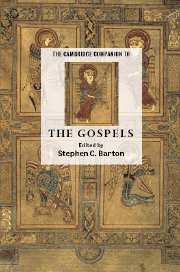Book contents
- Frontmatter
- Introduction
- Part I Approaching the gospels: context and method
- Part II The gospels as witnesses to Christ: content and interpretation
- 6 The Gospel according to Matthew
- 7 The Gospel according to Mark
- 8 The Gospel according to Luke
- 9 The Gospel according to John
- Part III The afterlife of the gospels: impact on church and society
6 - The Gospel according to Matthew
from Part II - The gospels as witnesses to Christ: content and interpretation
Published online by Cambridge University Press: 28 January 2007
- Frontmatter
- Introduction
- Part I Approaching the gospels: context and method
- Part II The gospels as witnesses to Christ: content and interpretation
- 6 The Gospel according to Matthew
- 7 The Gospel according to Mark
- 8 The Gospel according to Luke
- 9 The Gospel according to John
- Part III The afterlife of the gospels: impact on church and society
Summary
Written later than the Gospel of Mark (on which it almost certainly draws), in all likelihood at some time towards the end of the period 70-100-ce, the Gospel of Matthew came to be given priority of place among the four canonical gospels and therefore, subsequently, priority of place as the first book of the New Testament. From a theological point of view, this way of ordering the canon is suggestive. It conveys the conviction, held from early on, that Matthew's presentation of Jesus as the fulfilment of scripture and the hope of humankind is true and authoritative. Beginning as it does with a genealogy which displays Jesus' messianic identity as 'the son of David, the son of Abraham' (1.1), Matthew's gospel picks up, as it were, where Malachi, the last book of the Old Testament in its Septuagintal form, leaves off. Malachi ends with the prophecy of the return of the prophet Elijah 'before the great and terrible day of the Lord comes' (Mal 4.5). In Matthew, the end-time Elijah duly appears in the person of John the Baptist, preparing the way for 'the Lord', one whose identity is revealed at his baptism as Jesus, God's 'beloved Son' (3.17). The Gospel of Matthew, in other words, is a fulcrum between the Testaments in a traditional Christian reading. It expresses the fulfilment of the Old Testament (or 'covenant') and the beginning of the New.
- Type
- Chapter
- Information
- The Cambridge Companion to the Gospels , pp. 121 - 138Publisher: Cambridge University PressPrint publication year: 2006
- 1
- Cited by



